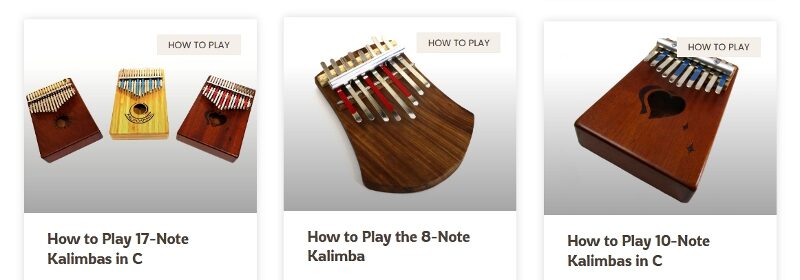At Kalimba Magic, we give you the tools to succeed on your kalimba journey. The kalimba has great depth and breadth, and you can gain a lot from the resources we have arrayed here for kalimba players at all levels. The “Learn to Play” section is a perfect place to help you start your journey.
Our job is to help you to understand your kalimba, how it is set up, and how to keep it sounding sweet and in tune.
We invented Kalimba Tablature in 2004 – of course we are the experts! Tablature is much easier to read than staff notation is – it is just a map of the kalimba, showing you which tines to play.

In addition to the general “How to Play” pages, we also have specific pages for many different types of kalimba. The above kalimbas are all good as intro level kalimbas, and of course, we have a lot of instructional materials for each of these.
The two rows of tines – one raised and one lower – is a traditional African way of organizing the tines. These instruments are actually much easier to play than the “all in one level” kalimba designs – the distance between adjacent tines is greater, making it more difficult to play the wrong tine. Also, certain combinations of notes become very easy (sliding off a raised tine to a lower tine). Check out these instruments if you are interested in an African flavored ride through Kalimba Land.
The Hugh Tracey Treble and Alto Kalimbas were the first non-traditional kalimbas to be sold outside of Africa, starting in 1954. These kalimbas have become the standard by which other kalimbas are judged, and they became the models for numerous copy kalimbas world wide.
There are also many kalimba innovations around the world: the new age music artist SaReGaMa has created several new tunings of the African karimbs. Magadi in China is now making high quality resonant kalimbas. And Hugh Tracey is making several models of Chromatic Kalimbas with the “flats” on the back and the “white notes” on the front.
The pentatonic kalimba is a great place to cut loose and go wild! It is an African scale that has been on kalimbas for centuries, and it is a great place to start. And, what if your kalimba is not here in the “How to Play” pages? We might have something else that will work for you.


Sign up for our newsletter and free resources with your email address:
We pinky promise not to spam you and to only send good stuff.
 Christmas in July 2025
Christmas in July 2025 Patriotic and American Music for Kalimba
Patriotic and American Music for Kalimba